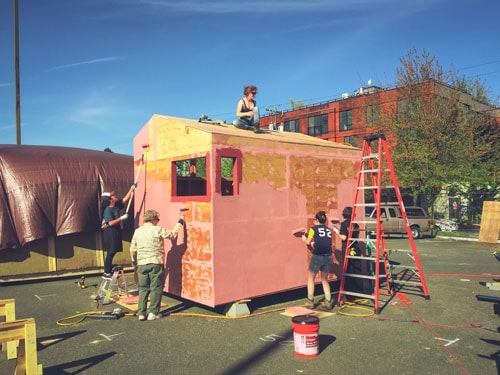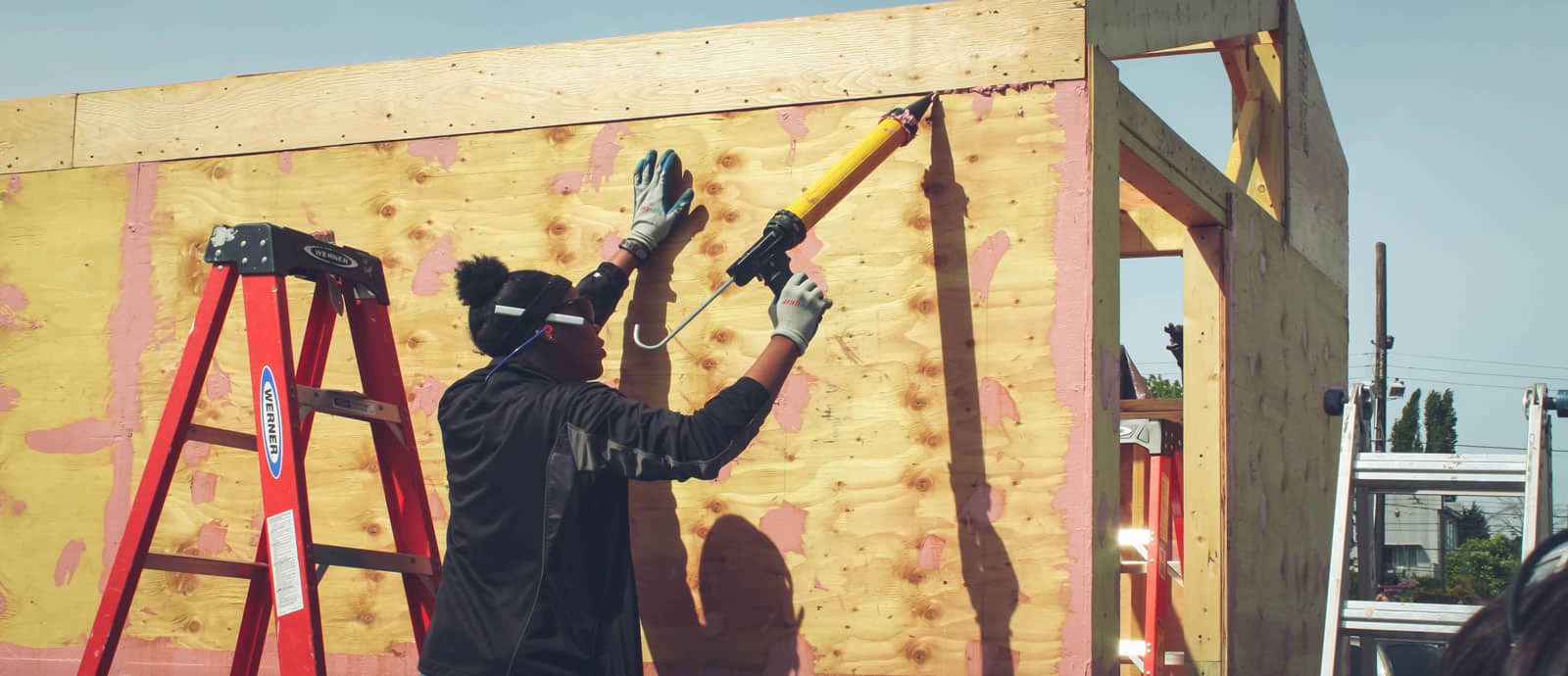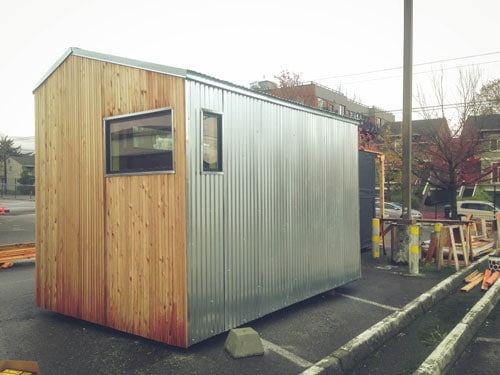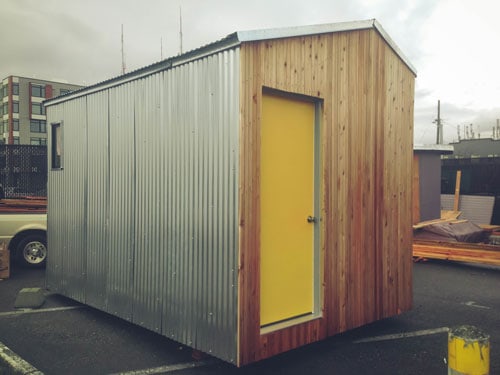A PROSOCO material donation gives back to a community in more ways than one.
In 2008, the U.S. was staring up at a tidal wave recession and Sarah Smith was facing a post-diploma job reality she had not anticipated.
“My assumption to that point was a job well done in college would result in a degree-related job after college. That theory simply didn’t pan out,” says Smith, who earned a degree in English literature from the University of Puget Sound.
Through her post-graduation experience, Smith found the lost puzzle piece was a lack of hands-on skills training in the nation’s traditional education system.
“When the U.S. school system was designed, a majority of youth worked in the fields and in the home with their hands. At that time, public education complemented that practical knowledge with the reading, writing, and arithmetic, creating a balance in learning that generally is no longer present,” she says.

Smith’s revelation served to repurpose her job aspirations and lay the ground work for Sawhorse Revolution, a passion project-turned-nonprofit that brings the design, engineering, and building trades to high school students from all walks of life, nurturing them into community-centric, confident and self-reliant youth.
Design and construction
The idea for Sawhorse originated when Smith and some friends volunteered at a farm outside of Seattle and pitched the idea of a camp to teach elementary kids basic building skills. “The first camp proved challenging, but we continued to try different projects with different age groups and through that trial and error process were able to organically uncover the idea for Sawhorse.”
Adam Nishimura, executive director of Sawhorse, had learned the carpentry trade after college and helped one camp build a treehouse. While the program had completed a variety of projects, this particular one received significant recognition from the community. “At that point we realized carpentry for teenagers was a possible niche for which we could get funding,” Smith says.
Fast-forward to 2012 -- with funds secured, the nonprofit launched with the initial vision to widen the educational paths of young people by teaching them hands-on skills.
To that purpose, the program pairs professional builders and mentors with diverse and under-privileged high school students, and together the teams engage in year-round, after-school activities ranging from introductory vocational programs to complete design-build projects.
Sawhorse students come from several highly diverse schools suffering from lack of resources where students choose to be part of a Sawhorse project. Smith says that as interest grows in the program, they’re moving toward that voluntary model.

Altruistic additions
In 2013, Sawhorse set its sights on tiny home design and construction with the forethought that the scope of work might just perfectly align with its program and that these inherently green abodes could be donated to the local homeless community.
With funding secured and a partnership established with Nickelsville Homeless Community, a Seattle-based homeless village, a Sawhorse project team completed its first tiny home in fall 2014.
“This inaugural build was our first foray into long format design and turned out to be very successful,” Smith says. “The fruition of the final product and knowledge that it would be a home for someone in need had an extraordinarily positive impact on the student team.”
To date, Sawhorse has built six tiny homes, one bathroom, and one wheelchair ramp for the Nickelsville Community; each tiny home is able to shelter up to four individuals.
Depending on the program, students design the project in the fall and construct in the spring, or a professional handles the initial design and participants the build. Teams consist of 15 students on average working in four-hour segments with a total of 40 to 50 hours spent on the shell of the home and another 30 plus spent constructing its furniture.

Attention to detail
In August 2016, Sawhorse marked another milestone as a project team comprised of all women completed the EASE.L House tiny home.
Smith says the inspiration for this project actually began with that first tiny home project that by coincidence featured an all-women design team. “It prompted us to really consider women’s roles, or lack thereof, in the building trades and brought us to the idea of an all-women’s team. This project illustrated to these women the possibilities in and rewards of such work and to both the women and community their capability in that field,” says Smith.
In addition to its goal of growing its students’ character and confidence by way of hands-on training, Sawhorse also strives to use quality materials to construct safe, beautiful habitats. Considering the Pacific Northwest’s general weather trends, quality waterproofing materials top the essential list.
When Sawhorse brainstormed waterproofing ideas for EASE.L House, they determined Lawrence, Kan.-based manufacturer PROSOCO’s product line the way to go. “Rain is the number one concern here,” says Smith. “We did our research and identified the PROSOCO materials as the product goal, but knew it would take a donation to make it financially possible.”
Sawhorse reached out to PROSOCO Northwest Regional Manager Jake Boyer. “We were happy to help and proud to be a part of the project,” Boyer says. “The opportunity to support a movement for healthier materials, greener building, and the homeless community’s needs for better living conditions, all in one, is one we were surely willing to support.”
PROSOCO donated materials from its R-Guard air and weather barrier system including its Spray Wrap MVP fluid-applied air and water-resistive barrier, as well as its FastFlash liquid flashing membrane and Joint & Seam Filler – both of which feature exclusive silyl-terminated polymer chemistry that makes the materials instantly waterproof upon application and enables them to be applied to damp surfaces.
Smith says the materials exceeded expectations. “Being able to use these products enhanced our curriculum as the students got to witness what water penetration could do to a home, considering all the places the Joint & Seam Filler ended up occupying,” she says. “Being able to use these high-quality materials ensured this home will be safe and dry and provided our students with a heightened sense of pride knowing they constructed something of quality and worth for a family in need.”


A house becomes a home
In the years since that first build in 2014, Smith says they have gained a clearer understanding of what Sawhorse project teams are capable of, as well as the needs of their homeless clients. “We keep things simple and that works well,” Smith says. “After all, the idea is to provide the house for the residents to then shape and make their home.”
Today the EASE.L House, a 9’x 13’ x 10’ tiny home, which features a modified saltbox roof style with a modern corrugated and cedar façade, is waiting to be placed in a new tiny home village, with existing villages currently full.
The Nickelsville organization determines the family or individual that will inhabit the home based on seniority, number and age of children, and long-standing contribution within the community. Smith says the house, which features a trundle-style bed and moveable storage wall, is ready to be made a home for whoever is selected.
As for the material donation, Smith points out that PROSOCO not only provided its students with quality products that enhanced their pride in the finished product, but also provided for those in their community the most in need of goodwill.
“As a fourth-generation, family-owned business, it’s in our DNA to help those in need and support movements to better the industry and communities we live and work in,” says Boyer.
![]()
About Sawhorse Revolution
Sawhorse Revolution is a Seattle-based nonprofit serving high school students primarily from central and south Seattle. The organization’s mission is to foster confident, community-oriented youth through the power of carpentry and craft. Sawhorse Revolution was founded by Sarah Smith, program director; Micah Stanovsky, operations director; and Adam Nishimura, executive director. The group has employed the building trades to professional and personally develop more than 200 students throughout central and south Seattle. Learn more at sawhorserevolution.org.